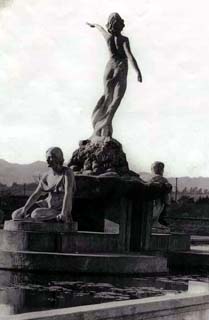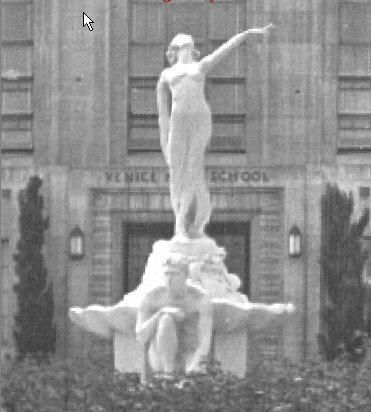
Myrna (The statue and history)
The Original (in 1921)

As we remember her (without the Uni Hi paint)

The History of the Statue
It's rare to find a monument erected to honor a single actor or actress.
It's even more unusual to find a statue of a movie star that was erected before they became a movie star.
But that's exactly what you'll find at Venice High School.
Right in front of the high school, in the middle of a small rose garden, is a larger-than-life-size statue of actress Myrna Loy. And it was made years before Myrna appeared in a single movie.
If the school looks familiar to you, it might be because you saw it featured as "Rydell High School" in the 1978 hit movie musical "Grease" (starring John Travolta & Olivia Newton-John) .
Look closely at the opening scenes of "Grease," and you can see the statue of Myrna Loy in front of "Rydell High" when John Travolta meets up with his buddies following their summer vacation (just as the movie's cartoon credits fade into an actual shot of the high school).
You'll also notice that when this movie was made, they hadn't yet erected the "cage" around the statue.
But the school's Hollywood history goes back a lot further than 1978. Myrna Loy was a student here before she broke into showbiz, and she posed for the statue that now stands out front.
Actually, it isn't a particularly good likeness of Miss Loy. Standing atop a stone pedestal, back arched, the short-haired figure is semi-nude (wearing only a thin gown which leaves little to the imagination), with one arm raised in a dramatic pose. The statue is located between two other white statues - one male, one female, both crouching.
All three statues were modeled by Venice High students, and the trio are meant to depict the "Mental," "Physical" and "Spiritual."
According to the bronze plaque on the east side of the pedestal, the statues were erected in 1921, which means that Myrna Loy (then named Myrna Williams) was only 16 years old when she posed for the "Spiritual" statue - long before she became a celebrity. So originally, the statue was meant simply as a work of art. Now, of course, it is a tribute to Venice High's most famous alumna. The school even named its annual drama award "the Myrna."
Those of us born too late to have seen most of her films (except on the "Late Show") may have forgotten just how big a star Myrna Loy really was, or what a rich film legacy she left.
Myrna Loy was discovered by Rudolph Valentino shortly after she left Venice High. She appeared in a few silent movies, and was even a chorus girl in 1927's landmark "The Jazz Singer," Hollywood's first talkie.
But it was in the late 1930's that Myrna Loy became M-G-M's top female star at the box office. She was named the most popular actress in Hollywood, and starred alongside such megastars as Cary Grant, Spencer Tracy, and Clark Gable (despite the fact that she turned down the starring role in "It Happened One Night.")
Her career took off in 1934 on a curious note, when she starred in "Manhattan Melodrama," the movie that lured bank robber John Dillinger out of hiding. (He was shot to death in an FBI ambush while leaving the Biograph Theatre after seeing her film.)
In that same year, she starred in the movie that would make her a household name: "The Thin Man" - based on the Dashiell Hammett novel of the same name. In the "Thin Man" films, Myrna Loy was paired with William Powell, as Nick & Nora Charles, a witty, wealthy, urbane married couple who oozed sophisticated charm, and (together with their dog, "Asta") solved murder mysteries on the side.
The chemistry was magic, and she and William Powell went on to make 14 movies together, including "Another Thin Man," "Shadow of the Thin Man," "The Thin Man Goes Home," etc. (The "Thin Man" formula has often been copied since then, most recently in the Robert Wagner / Stephanie Powers' TV series, "Hart To Hart.")
In 1937, Ed Sullivan asked his 20 million readers to vote for the "King and Queen of Hollywood." Clark Gable won the title of "The King "; Myrna Loy was chosen as "The Queen."
During World War II, Myrna Loy unselfishly put aside her Hollywood career and became a full-time Red Cross worker. After the war, she returned to the movies, making light comedies with Cary Grant such as "Mr. Blandings Builds His Dream House" (1948) and "The Bachelor & the Bobby-Soxer" (1947), plus the nostalgic "Cheaper By the Dozen" (1950) with Clifton Webb. But she also starred in outstanding dramas such as "The Best Years of Our Lives" (1946), widely hailed as one of the best movies ever made in Hollywood.
Later in her career, Ms. Loy was involved in politics (supporting UNESCO), and starred on the Broadway stage. She never received an Academy Award nomination for her films, but she was awarded an honorary Oscar in 1991, two years before she died.
Unfortunately, the Venice High statue today is in poor condition, showing obvious signs of wear, vandalism and rust. The bronze plaque on the pedestal of the statue at Venice High mentions a restoration effort, so I assume that the statue had been damaged badly at some time in the past. To prevent future damage, there is now surrounded by an tall cage of white metal bars.
(* Be warned that the area has been the scene of recent gang activity. Exercise reasonable caution.)
The latest report is that the Statue of Myrna no longer stands out front.
It has been located on campus in pieces